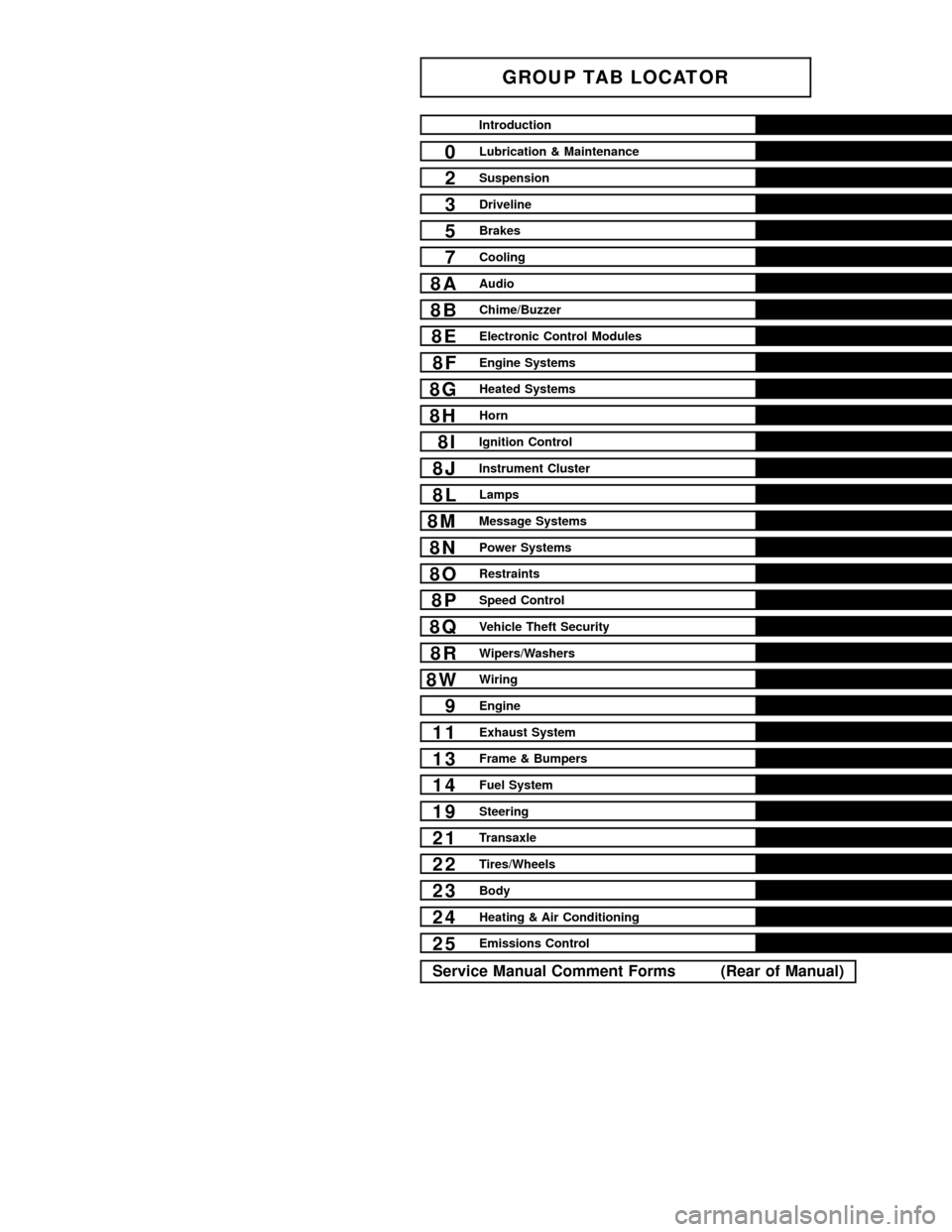Wiper control JEEP GRAND CHEROKEE 2002 WJ / 2.G Workshop Manual
[x] Cancel search | Manufacturer: JEEP, Model Year: 2002, Model line: GRAND CHEROKEE, Model: JEEP GRAND CHEROKEE 2002 WJ / 2.GPages: 2199, PDF Size: 76.01 MB
Page 1 of 2199

GROUP TAB LOCATOR
Introduction
0Lubrication & Maintenance
2Suspension
3Driveline
5Brakes
7Cooling
8AAudio
8BChime/Buzzer
8EElectronic Control Modules
8FEngine Systems
8GHeated Systems
8HHorn
8IIgnition Control
8JInstrument Cluster
8LLamps
8MMessage Systems
8NPower Systems
8ORestraints
8PSpeed Control
8QVehicle Theft Security
8RWipers/Washers
8WWiring
9Engine
11Exhaust System
13Frame & Bumpers
14Fuel System
19Steering
21Transaxle
22Tires/Wheels
23Body
24Heating & Air Conditioning
25Emissions Control
Service Manual Comment Forms (Rear of Manual)
Page 5 of 2199

FASTENER USAGE
DESCRIPTION - FASTENER USAGE
WARNING: USE OF AN INCORRECT FASTENER
MAY RESULT IN COMPONENT DAMAGE OR PER-
SONAL INJURY.
Fasteners and torque specifications references in
this Service Manual are identified in metric and SAE
format.
During any maintenance or repair procedures, it is
important to salvage all fasteners (nuts, bolts, etc.)
for reassembly. If the fastener is not salvageable, a
fastener of equivalent specification must be used.
THREADED HOLE REPAIR
DESCRIPTION - THREADED HOLE REPAIR
Most stripped threaded holes can be repaired using
a Helicoilt. Follow the vehicle or Helicoiltrecommen-
dations for application and repair procedures.
INTERNATIONAL SYMBOLS
DESCRIPTION - INTERNATIONAL SYMBOLS
The graphic symbols illustrated in the following
International Control and Display Symbols Chart are
used to identify various instrument controls. The
symbols correspond to the controls and displays that
are located on the instrument panel.
INTERNATIONAL SYMBOLS
1 High Beam 13 Rear Window Washer
2 Fog Lamps 14 Fuel
3 Headlamp, Parking Lamps, Panel Lamps 15 Engine Coolant Temperature
4 Turn Warning 16 Battery Charging Condition
5 Hazard Warning 17 Engine Oil
6 Windshield Washer 18 Seat Belt
7 Windshield Wiper 19 Brake Failure
8 Windshield Wiper and Washer 20 Parking Brake
9 Windscreen Demisting and Defrosting 21 Front Hood
10 Ventilating Fan 22 Rear hood (Decklid)
11 Rear Window Defogger 23 Horn
12 Rear Window Wiper 24 Lighter
4 INTRODUCTIONWJ
Page 313 of 2199

BCM programming then performs those tasks and
provides features through both PCI data bus commu-
nication with other electronic modules and hard
wired outputs to a number of relays. These relays
provide the BCM with the ability to control numer-
ous high current accessory systems in the vehicle.
The BCM circuitry operates on battery current
received through fuses in the Junction Block (JB) on a
non-switched fused B(+) circuit, a fused ignition switch
output (start-run) circuit, and a fused ignition switch
output (run-accessory) circuit. This arrangement allows
the BCM to provide some features regardless of the
ignition switch position. The BCM circuitry is grounded
through the chassis beneath the center console.
The BCM monitors its own internal circuitry as
well as many of its input and output circuits, and
will store a Diagnostic Trouble Code (DTC) in elec-
tronic memory for any failure it detects. These DTCs
can be retrieved and diagnosed using a DRBIIItscan
tool. Refer to the appropriate diagnostic information.
HARD WIRED INPUTS
The hard wired inputs to the BCM include the fol-
lowing:
²A/C switch signal
²Ambient temperature sensor signal
²Body control module flash enable
²Coolant level switch sense
²Door ajar switch sense (two circuits - one left
rear, and one right rear)
²Driver seat heater switch mux
²Fog lamp switch sense
²Fused B(+)
²Fused ignition switch output (run-acc)
²Fused ignition switch output (st-run)
²Ground (five circuits - two Z1, and three Z2)
²Hazard switch sense
²Headlamp switch mux
²High beam switch sense
²Hood ajar switch sense (export)
²Key-in ignition switch sense
²Liftgate ajar switch sense
²Liftgate courtesy disable
²Liftgate flip-up ajar switch sense
²Panel lamps dimmer signal
²Park lamp relay output
²Passenger seat heater switch mux
²PCI bus
²Radio control mux
²Rear window defogger switch sense
²Seat belt switch sense
²Ultralight sensor signal
²Washer fluid switch sense
²Washer pump switch sense
²Windshield wiper switch mux
²Wiper park switch sense
MESSAGING
The BCM uses the following messages received
from other electronic modules over the PCI data bus:
²Accessory Delay Control (DDM/PDM)
²Battery Temperature (PCM)
²Chime Request (EMIC, EVIC, SKIM)
²Cylinder Lock Switch Status (DDM)
²Door Ajar Status/Front Doors (DDM/PDM)
²Door Lock Status (DDM/PDM)
²Engine Model (PCM)
²Engine RPM (PCM)
²Engine Temperature (PCM)
²English/Metric Default (EMIC)
²Fuel Tank Level (PCM)
²Fuel Used/Injector Pulses (PCM)
²Panic Control (PDM)
²Programmable Features Preferences/Audible &
Optical Chirps/Headlamp Delay (EVIC)
²RKE Status (PDM)
²Vehicle Identification Number (PCM)
²Vehicle Speed (PCM)
The BCM provides the following messages to other
electronic modules over the PCI data bus:
²A/C Switch Status (PCM)
²Ambient Temperature Data (AZC/EVIC/PCM)
²Average/Instantaneous Fuel Economy (EVIC)
²Country Code (EMIC)
²Courtesy Lamp Status (DDM/PDM)
²Distance To Empty (EVIC)
²Elapsed Ignition On Timer (EVIC)
²English/Metric Status (EMIC)
²Front & Rear Door Ajar Status (EVIC)
²Front & Rear Fog Lamp Status (EMIC)
²Heated Seat Switch Status (HSM/MHSM)
²High Beam Status (EMIC)
²Ignition Off Timer (EVIC)
²Ignition Switch Position (DDM/PDM)
²Key-In Ignition Status (DDM/PDM)
²Low Beam Status (EMIC)
²Panel Lamp Status (AZC/EMIC/Radio)
²Rear Window Defogger Relay Status (DDM/
PDM)
²Remote Radio Switch Status (Radio)
²Seatbelt Status (EMIC/MHSM/MSM)
DIAGNOSIS AND TESTING - BODY CONTROL
MODULE
The hard wired inputs to and outputs from the
Body Control Module (BCM) may be diagnosed and
tested using conventional diagnostic tools and proce-
dures. Refer to the appropriate wiring information.
Conventional diagnostic methods may not prove
conclusive in the diagnosis of the BCM. In order to
obtain conclusive testing of the BCM, the Program-
mable Communications Interface (PCI) data bus net-
work and all of the electronic modules that provide
8E - 4 ELECTRONIC CONTROL MODULESWJ
BODY CONTROL MODULE (Continued)
Page 481 of 2199

wired between a body ground, the Body Control Mod-
ule (BCM) and the rear wiper motor module through
the liftgate and body wire harnesses.
The liftgate flip-up glass ajar switch cannot be
adjusted or repaired and, if faulty or damaged, the
liftgate flip-up glass latch unit must be replaced.
(Refer to 23 - BODY/DECKLID/HATCH/LIFTGATE/
TAILGATE/FLIP-UP GLASS LATCH - REMOVAL)
for the service procedures. For complete circuit dia-
grams, refer to the appropriate wiring information.
DESCRIPTION - LIFTGATE AJAR SWITCH
The two liftgate ajar switches are integral to the
two liftgate latch mechanisms. The two liftgate ajar
switches are actuated by the liftgate latch mecha-
nisms, and are hard wired with each other between a
body ground and the Body Control Module (BCM)
through the liftgate and body wire harnesses.
The liftgate ajar switches cannot be adjusted or
repaired and, if faulty or damaged, the liftgate latch
unit must be replaced. (Refer to 23 - BODY/DECK-
LID/HATCH/LIFTGATE/TAILGATE/LATCH -
REMOVAL) for the service procedures. For complete
circuit diagrams, refer to the appropriate wiring
information.
OPERATION
OPERATION - DOOR AJAR SWITCH
The front door ajar switches close a path to ground
for the DDM or the PDM when a front door is
opened, and opens the ground path when a front door
is closed. The rear door ajar switches close a path to
ground for the BCM when a rear door is opened, and
opens the ground path when a rear door is closed.
The DDM, PDM, or BCM read the switch status then
send the proper switch status messages to other
modules over the Programmable Communications
Interface (PCI) data bus network. The door ajar
switch status message is used by the BCM as an
input for Vehicle Theft Security System (VTSS) oper-
ation.
OPERATION - FLIP UP GLASS AJAR SWITCH
The liftgate flip-up glass ajar switch can close a
path to ground for the BCM and the rear wiper
motor module when the liftgate flip-up glass is
opened, and opens the ground path when the liftgate
flip-up glass is closed. The rear wiper motor module
uses the liftgate flip-up glass ajar switch input to
control the rear wiper operation, and will park the
rear wiper blade if this input indicates that the lift-
gate flip-up glass is ajar. The BCM reads the switch
status then sends the proper switch status message
to other modules over the Programmable Communi-cations Interface (PCI) data bus network. The liftgate
flip-up glass ajar switch status message is used by
the BCM as an input for Vehicle Theft Security Sys-
tem (VTSS) operation.
OPERATION - LIFTGATE AJAR SWITCH
Each of the liftgate ajar switches can close a path
to ground for the BCM when the liftgate is opened,
and opens the ground path when the liftgate is
closed. The BCM reads the switch status then sends
the proper switch status message to other modules
over the Programmable Communications Interface
(PCI) data bus network. The liftgate ajar switch sta-
tus message is used by the BCM as an input for
Vehicle Theft Security System (VTSS) operation.
DIAGNOSIS AND TESTING - DOOR AJAR
SWITCH
The following diagnosis and testing is only
for the chime functions. For interior lamp diag-
nosis, refer to the appropriate wiring informa-
tion.The driver door ajar switch is hard wired to the
Driver Door Module (DDM). The DDM communicates
the switch status to the other modules in the vehicle
on the Programmable Communications Interface
(PCI) data bus network. The following test will diag-
nose a faulty driver door ajar switch and circuits. For
complete circuit diagrams, refer to the appropriate
wiring information.
WARNING: ON VEHICLES EQUIPPED WITH AIR-
BAGS, REFER TO ELECTRICAL, RESTRAINTS
BEFORE ATTEMPTING ANY STEERING WHEEL,
STEERING COLUMN, OR INSTRUMENT PANEL
COMPONENT DIAGNOSIS OR SERVICE. FAILURE
TO TAKE THE PROPER PRECAUTIONS COULD
RESULT IN ACCIDENTAL AIRBAG DEPLOYMENT
AND POSSIBLE PERSONAL INJURY.
(1) Check that the interior lighting switch on the
control stalk of the left multi-function switch is not
in the dome lamp disable position. Open the driver
side front door and note whether the interior lamps
light. They should light. If OK, refer to Key-In Igni-
tion Switch in the Diagnosis and Testing section of
this group for further diagnosis of the chime warning
system. If not OK, go to Step 2.
(2) Disconnect and isolate the battery negative
cable. Remove the trim panel from the driver front
door and disconnect the 4-way door wire harness con-
nector from the front door latch connector. Check for
continuity between the ground circuit of the 4-way
door wire harness connector and a good ground.
There should be continuity. If OK, go to Step 3. If not
OK, repair the ground circuit.
8L - 30 LAMPS/LIGHTING - INTERIORWJ
DOOR AJAR SWITCH (Continued)
Page 609 of 2199

FRONT WIPERS/WASHERS
DESCRIPTION
An electrically operated intermittent front wiper
and washer system is standard factory-installed
safety equipment on this model (Fig. 1). The front
wiper and washer system includes the following
major components, which are described in further
detail elsewhere in this service information:²Body Control Module- The Body Control
Module (BCM) is located on the Junction Block (JB)
under the driver side outboard end of the instrument
panel. (Refer to 8 - ELECTRICAL/ELECTRONIC
CONTROL MODULES/BODY CONTROL MODULE
- DESCRIPTION).
Fig. 1 Front Wiper & Washer System
1 - WASHER RESEVOIR FILLER TUBE
2 - WASHER RESERVOIR, PUMP/MOTOR, FLUID LEVEL
SWITCH
3 - WASHER NOZZLE (2)
4 - WIPER MODULE5 - WIPER ARM & BLADE (2)
6 - RIGHT (WIPER) MULTI-FUNCTION SWITCH RIGHT
7 - RAIN SENSOR MODULE
8R - 2 FRONT WIPERS/WASHERSWJ
Page 610 of 2199

²Front Check Valve- The front washer system
check valve is integral to the wye fitting located in
the washer plumbing between the cowl plenum
washer hose and the front washer nozzles, and is
concealed beneath the cowl plenum cover/grille panel
at the base of the windshield.
²Front Washer Nozzle- Two fluidic front
washer nozzles are secured with integral snap fea-
tures to dedicated openings in the cowl plenum cover/
grille panel located near the base of the windshield.
²Front Washer Plumbing- The plumbing for
the front washer system consists of rubber hoses and
molded plastic fittings. The plumbing is routed along
the left side of the engine compartment from the
washer reservoir, and through the dash panel into
the cowl plenum to the front washer nozzle fittings
beneath the cowl plenum cover/grille panel.
²Front Washer Pump/Motor- The front washer
pump/motor unit is located in a dedicated hole on the
lower outboard side of the washer reservoir, behind
the inner fender liner ahead of the left front wheel.
The front washer pump is located ahead of and below
the rear washer pump.
²Front Wiper Arm- The two front wiper arms
are secured with nuts to the threaded studs on the
ends of the two wiper pivot shafts, which extend
through the cowl plenum cover/grille panel located
near the base of the windshield.
²Front Wiper Blade- The two front wiper
blades are secured to the two front wiper arms with
an integral latch, and are parked on the glass near
the bottom of the windshield when the front wiper
system is not in operation.
²Front Wiper Module- The front wiper pivot
shafts are the only visible components of the front
wiper module. The remainder of the module is con-
cealed within the cowl plenum beneath the cowl ple-
num cover/grille panel. The front wiper module
includes the module bracket, four rubber-isolated
wiper module mounts, the front wiper motor, the
wiper motor crank arm, the two wiper drive links,
and the two front wiper pivots.
²Rain Sensor Module- Models equipped with
the optional automatic wiper feature have a Rain
Sensor Module (RSM) located behind a trim cover on
a bracket bonded to the inside surface of the wind-
shield glass, just above the inside rear view mirror
mounting button.
²Right Multi-Function Switch- The right
(wiper) multi-function switch is secured to the right
side of the multi-function switch mounting housing
near the top of the steering column, just below the
steering wheel. Only the control stalk for the right
multi-function switch is visible, while the remainder
of the switch is concealed beneath the steering col-
umn shrouds. The right multi-function switch con-tains all of the switches and control circuitry for both
the front and rear wiper and washer systems.
²Washer Fluid Level Switch- The washer fluid
level switch is located in a dedicated hole near the
center of the forward surface of the washer reservoir,
behind the left front wheel house splash shield.
²Washer Reservoir- The washer reservoir is
concealed between the left inner fender shield and
the left outer fender panel, behind the inner fender
liner and ahead of the left front wheel. The washer
reservoir filler neck is the only visible portion of the
reservoir, and it is accessed from the left front corner
of the engine compartment.
²Wiper High-Low Relay- The wiper high-low
relay is an International Standards Organization
(ISO) micro relay located in the Power Distribution
Center (PDC) in the engine compartment near the
battery.
²Wiper On-Off Relay- The wiper on-off relay is
an International Standards Organization (ISO) micro
relay located in the Power Distribution Center (PDC)
in the engine compartment near the battery.
Hard wired circuitry connects the front wiper and
washer system components to the electrical system of
the vehicle. These hard wired circuits are integral to
several wire harnesses, which are routed throughout
the vehicle and retained by many different methods.
These circuits may be connected to each other, to the
vehicle electrical system and to the front wiper and
washer system components through the use of a com-
bination of soldered splices, splice block connectors,
and many different types of wire harness terminal
connectors and insulators. Refer to the appropriate
wiring information. The wiring information includes
wiring diagrams, proper wire and connector repair
procedures, further details on wire harness routing
and retention, as well as pin-out and location views
for the various wire harness connectors, splices and
grounds.
OPERATING MODES
The components of the front wiper and washer sys-
tem are designed to work in concert to provide the
following operating modes:
²Automatic Wiper- In models equipped with
the optional automatic wiper feature, the internal
circuitry of both the right (wiper) multi-function
switch, the rain sensor module, and the BCM work
in concert to provide an automatic wiper mode with
five sensitivity selections. The BCM tells the Rain
Sensor Module (RSM) when the automatic wiper
mode is selected and the manually selected sensitiv-
ity level, then the rain sensor module tells the BCM
each time enough water droplets have accumulated
within the wipe pattern on the windshield to require
front wiper operation. The BCM then automatically
WJFRONT WIPERS/WASHERS 8R - 3
FRONT WIPERS/WASHERS (Continued)
Page 611 of 2199

operates the front wipers at the programmed speed
and intervals requested by the RSM to maintain vis-
ibility through the windshield.
²Continuous Wipe Mode- The control knob on
the control stalk of the right (wiper) multi-function
switch has two continuous wipe positions, Low and
High. When selected, these switch positions will
cause the two-speed front wiper motor to operate in a
continuous low or high speed cycle.
²Headlamps On With Wipers- The BCM pro-
vides an automatic headlamps on with wipers feature
for models equipped with the optional automatic
headlamps. This is a customer programmable fea-
ture. If this feature is enabled, the headlamps will
turn on automatically when the windshield wipers
are turned on; and, if the headlamps were turned on
automatically when the wipers were turned on, they
will turn off automatically when the wipers are
turned off. In models equipped with the optional
automatic wiper feature, when the automatic wiper
mode is selected the headlamps will turn on auto-
matically only after the wipers complete three auto-
matic wipe cycles within about thirty seconds, and
they will turn off automatically after three minutes
elapse without any automatic wipe cycles. (Refer to 8
- ELECTRICAL/OVERHEAD CONSOLE - STAN-
DARD PROCEDURE - ELECTRONIC VEHICLE
INFORMATION CENTER PROGRAMMING).
²Mist Wipe Mode- The control stalk of the right
(wiper) multi-function switch has a momentary Mist
position. When selected, this switch position will
operate the front wipers in a low speed continuous
cycle for as long as the switch is held closed, then
will complete the current wipe cycle and park the
front wiper blades near the base of the windshield
when the switch is released.
²Speed Sensitive Intermittent Wipe Mode-
Except on models equipped with the optional auto-
matic wiper system, the internal circuitry of both the
right (wiper) multi-function switch and the BCM
work in concert to provide an intermittent wipe mode
with five delay interval selections. The BCM auto-
matically adjusts each manually selected delay inter-
val to compensate for vehicle speed.
²Washer Mode- When the momentary front
wash position of the control stalk for the right
(wiper) multi-function switch is selected with the
front wiper system operating in a continuous wipe
mode, washer fluid will be dispensed onto the wind-
shield glass through the washer nozzles for as long
as the washer switch is held closed. When the front
washer switch is actuated with the front wiper sys-
tem operating in an intermittent wipe mode, washer
fluid is still dispensed until the switch is released;
however, the front wipers will operate in a low speed
continuous cycle from the time the washer switch isclosed until several wipe cycles after the switch is
released, before returning to the selected intermit-
tent wipe mode.
²Wipe-After-Wash Mode- When the momentary
front wash position of the control stalk for the right
(wiper) multi-function switch is selected with the
front wiper system turned Off, the internal circuitry
of the BCM provides a wipe-after-wash feature.
When selected, this feature will operate the front
washer pump/motor and the front wipers for as long
as the front washer switch is held closed, then pro-
vide several additional wipe cycles after the switch is
released before parking the front wiper blades near
the base of the windshield.
OPERATION
The front wiper and washer system is designed to
provide the vehicle operator with a convenient, safe,
and reliable means of maintaining visibility through
the windshield glass. The various components of this
system are designed to convert electrical energy pro-
duced by the vehicle electrical system into the
mechanical action of the wiper blades to wipe the
outside surface of the glass, as well as into the
hydraulic action of the washer system to apply
washer fluid stored in an on-board reservoir to the
area of the glass to be wiped. When combined, these
components provide the means to effectively main-
tain clear visibility for the vehicle operator by remov-
ing excess accumulations of rain, snow, bugs, mud, or
other minor debris that might be encountered while
driving the vehicle under numerous types of inclem-
ent operating conditions from the outside windshield
glass surface.
The vehicle operator initiates all front wiper and
washer system functions with the control stalk of the
right (wiper) multi-function switch that extends from
the right side of the steering column, just below the
steering wheel. Rotating the control knob on the end
of the right (wiper) multi-function switch control
stalk selects the Off, Delay (on models not equipped
with the optional automatic wiper system), Auto (on
models equipped with the optional automatic wiper
system), Low, or High front wiper system operating
modes. In the Delay mode, the control knob also
allows the vehicle operator to select from one of five
intermittent wipe Delay intervals. In the Auto mode,
the control knob also allows the vehicle operator to
select from one of five automatic wiper sensitivity
levels. Pulling the right control stalk downwards
actuates the momentary front wiper system Mist
mode switch, while pulling the right control stalk
towards the steering wheel actuates the front washer
system switch. The multi-function switch provides
hard wired resistor multiplexed inputs to the Body
Control Module (BCM) for all of the front wiper sys-
8R - 4 FRONT WIPERS/WASHERSWJ
FRONT WIPERS/WASHERS (Continued)
Page 612 of 2199

tem functions, as well as separate hard wired sense
inputs to the BCM for the high speed continuous
wipe and front washer system functions.
The front wiper and washer system will only oper-
ate when the ignition switch is in the Accessory or
On positions. Battery current is directed from a B(+)
fuse in the Power Distribution Center (PDC) to the
wiper and washer system circuit breaker in the Junc-
tion Block (JB) through a fused ignition switch out-
put (run-acc) circuit. The automatic resetting circuit
breaker then provides battery current through a
fused ignition switch output (run-acc) circuit to the
wiper on/off relay, and the park switch in the front
wiper motor. A separate fuse in the JB provides bat-
tery current through another fused ignition switch
output (run-acc) circuit to the right multi-function
switch. The right multi-function switch circuitry uses
this battery feed to directly control the operation of
the front washer pump/motor unit. The BCM uses
low side drivers to control front wiper system opera-
tion by energizing or de-energizing the wiper high/
low and wiper on/off relays.
The hard wired circuits and components of the
front wiper and washer system may be diagnosed
and tested using conventional diagnostic tools and
procedures. However, conventional diagnostic meth-
ods may not prove conclusive in the diagnosis of the
Body Control Module (BCM), or the inputs to or out-
puts from the BCM that control the front wiper and
washer system operating modes. The most reliable,
efficient, and accurate means to diagnose the BCM,
or the BCM inputs and outputs related to the various
front wiper and washer system operating modes
requires the use of a DRBIIItscan tool. Refer to the
appropriate diagnostic information.
Following are paragraphs that briefly describe the
operation of each of the front wiper and washer sys-
tem operating modes.
CONTINUOUS WIPE MODE
When the Low position of the control knob on the
control stalk of the right (wiper) multi-function
switch is selected, the Body Control Module (BCM)
energizes the wiper on/off relay. This directs battery
current through the normally open contacts of the
energized wiper on/off relay and the normally closed
contacts of the de-energized wiper high/low relay to
the low speed brush of the front wiper motor, causing
the front wipers to cycle at low speed. When the
High position of the control knob is selected, the
BCM energizes both the wiper on/off relay and the
wiper high/low relay. This directs battery current
through the normally open contacts of the energized
wiper on/off relay and the normally open contacts of
the energized wiper high/low relay to the high speedbrush of the front wiper motor, causing the front wip-
ers to cycle at high speed.
When the Off position of the control knob is
selected, the BCM de-energizes both the wiper on/off
and wiper high/low relays, then one of two events
will occur. The event that will occur depends upon
the position of the wiper blades on the windshield at
the moment that the control knob Off position is
selected. If the wiper blades are in the down position
on the windshield when the Off position is selected,
the park switch that is integral to the front wiper
motor is closed to ground and the wiper motor ceases
to operate. If the wiper blades are not in the down
position on the windshield at the moment the Off
position is selected, the park switch is closed to bat-
tery current from the fused ignition switch output
(run-acc) circuit of the front wiper motor. The park
switch directs this battery current to the low speed
brush of the wiper motor through the wiper park
switch sense circuit and the normally closed contacts
of the wiper on/off and wiper high/low relays. This
causes the wiper motor to continue running at low
speed until the wiper blades are in the down position
on the windshield and the park switch is again
closed to ground.
INTERMITTENT WIPE MODE
On models not equipped with the optional auto-
matic wiper system, when the control knob on the
control stalk of the right (wiper) multi-function
switch is moved to one of the five Delay interval posi-
tions, the BCM electronic intermittent wipe logic cir-
cuit responds by calculating the correct length of
time between wiper sweeps based upon the selected
delay interval input. The BCM monitors the chang-
ing state of the wiper motor park switch through a
hard wired front wiper park switch sense circuit
input. This input allows the BCM to determine the
proper intervals at which to energize and de-energize
the wiper on/off relay to operate the front wiper
motor intermittently for one low speed cycle at a
time. The BCM logic is also programmed to provide
an immediate wipe cycle and begin a new delay
interval timing cycle each time a shorter delay inter-
val is selected, and to add the remaining delay tim-
ing interval to the new delay interval timing before
the next wipe cycle occurs each time a longer delay
interval is selected.
The intermittent wipe mode delay times are speed
sensitive. The BCM monitors vehicle speed messages
received from the Powertrain Control Module (PCM)
over the Programmable Communications Interface
(PCI) data bus network in order to provide the speed
sensitive delay intervals. Above about sixteen kilome-
ters-per-hour (ten miles-per-hour) the delay is driver
adjustable from about one-half second to about eigh-
WJFRONT WIPERS/WASHERS 8R - 5
FRONT WIPERS/WASHERS (Continued)
Page 613 of 2199

teen seconds. Below about sixteen kilometers-per-
hour (ten miles-per-hour) the delay times are
doubled, from about one second to about thirty-six
seconds.
AUTOMATIC WIPE MODE
On models equipped with the optional automatic
wiper system, when the control knob on the control
stalk of the right (wiper) multi-function switch is
moved to one of the five Auto sensitivity positions,
the BCM sends an electronic message to the Rain
Sensor Module (RSM) over the Programmable Com-
munications Interface (PCI) data bus network indi-
cating the selected position. The RSM monitors an
area within the wipe pattern of the windshield glass
for the accumulation of moisture. Based upon inter-
nal programming and the selected sensitivity level,
when sufficient moisture has accumulated the RSM
sends the appropriate electronic wipe command mes-
sages to the BCM over the PCI data bus and the
BCM operates the front wiper system accordingly. As
the sensitivity level is set higher, the RSM is more
sensitive to moisture accumulation and will send
wipe commands more frequently. The BCM logic is
also programmed to provide an immediate wipe cycle
each time the control knob on the control stalk of the
right multi-function switch is moved from a non-au-
tomatic wipe position to one of the five Auto sensitiv-
ity positions, and another immediate wipe cycle each
time the control knob is moved from a lower Auto
sensitivity position to a higher Auto sensitivity posi-
tion.
MIST WIPE MODE
When the control stalk of the right (wiper) multi-
function switch is moved to the momentary Mist
position, the BCM energizes the wiper on/off relay for
as long as the Mist switch is held closed, then de-en-
ergizes the relay when the state of the Mist switch
input changes to open. The BCM can operate the
front wiper motor in this mode for only one low speed
cycle at a time, or for an indefinite number of
sequential low speed cycles, depending upon how
long the Mist switch is held closed.
WASH MODE
When the control stalk of the right (wiper) multi-
function switch is moved to the momentary front
Wash position while the control knob is in the Low or
High positions, the circuitry within the switch directs
battery current to the front washer pump/motor unit.
This will cause the front washer pump/motor unit to
be energized for as long as the front Wash switch is
held closed, and to de-energize when the front Wash
switch is released. When the control stalk of the
right (wiper) multi-function switch is moved to the
momentary front Wash position while the controlknob is in one of the Delay interval or Auto sensitiv-
ity positions, the front washer pump/motor operation
is the same. However, the BCM energizes the wiper
on/off relay to override the selected delay interval or
auto sensitivity level and operate the front wiper
motor in a continuous low speed mode for as long as
the front Wash switch is held closed, then de-ener-
gizes the relay and reverts to the selected delay mode
interval or auto sensitivity level several wipe cycles
after the front Wash switch is released. The BCM
detects the front Wash switch state through a hard
wired washer pump motor switch output circuit input
from the right multi-function switch.
WIPE-AFTER-WASH MODE
When the control stalk of the right (wiper) multi-
function switch is moved to the momentary front
Wash position while the control knob is in the Off
position, the BCM detects that switch state through
a hard wired washer pump motor switch output cir-
cuit input from the right multi-function switch. The
BCM responds to this input by energizing the wiper
on/off relay for as long as the Wash switch is held
closed, then de-energizes the relay several wipe
cycles after the front Wash switch is released. The
BCM monitors the changing state of the wiper motor
park switch through a hard wired front wiper park
switch sense circuit input. This input allows the
BCM to count the number of wipe cycles that occur
after the front Wash switch state changes to open,
and to determine the proper interval at which to de-
energize the wiper on/off relay to complete the wipe-
after-wash mode cycle.
DIAGNOSIS AND TESTING - FRONT WIPER &
WASHER SYSTEM
FRONT WIPER SYSTEM
If the front wiper motor operates, but the wipers
do not move on the windshield, replace the faulty
front wiper module. If the wipers operate, but chat-
ter, lift, or do not clear the glass, clean and inspect
the wiper system components as required. (Refer to 8
- ELECTRICAL/FRONT WIPERS/WASHERS -
INSPECTION) and (Refer to 8 - ELECTRICAL/
FRONT WIPERS/WASHERS - CLEANING). Refer to
the appropriate wiring information. The wiring infor-
mation includes wiring diagrams, proper wire and
connector repair procedures, details of wire harness
routing and retention, connector pin-out information
and location views for the various wire harness con-
nectors, splices and grounds.
The hard wired circuits and components of the
front wiper and washer system may be diagnosed
and tested using conventional diagnostic tools and
procedures. However, conventional diagnostic meth-
8R - 6 FRONT WIPERS/WASHERSWJ
FRONT WIPERS/WASHERS (Continued)
Page 614 of 2199

ods may not prove conclusive in the diagnosis of the
Body Control Module (BCM), the Rain Sensor Mod-
ule (RSM), the Powertrain Control Module (PCM) or
the inputs to or outputs from these modules that con-
trol the various front wiper and washer system oper-
ating modes. The most reliable, efficient, and
accurate means to diagnose the BCM, the RSM, the
PCM or the BCM inputs and outputs related to the
various front wiper and washer system operating
modes requires the use of a DRBIIItscan tool. Refer
to the appropriate diagnostic information.
WARNING: ON VEHICLES EQUIPPED WITH AIR-
BAGS, DISABLE THE SUPPLEMENTAL RESTRAINT
SYSTEM BEFORE ATTEMPTING ANY STEERING
WHEEL, STEERING COLUMN, DRIVER AIRBAG,
PASSENGER AIRBAG, SIDE CURTAIN AIRBAG,
FRONT IMPACT SENSOR, SIDE IMPACT SENSOR,
OR INSTRUMENT PANEL COMPONENT DIAGNOSIS
OR SERVICE. DISCONNECT AND ISOLATE THE
BATTERY NEGATIVE (GROUND) CABLE, THEN
WAIT TWO MINUTES FOR THE SYSTEM CAPACI-
TOR TO DISCHARGE BEFORE PERFORMING FUR-
THER DIAGNOSIS OR SERVICE. THIS IS THE ONLY
SURE WAY TO DISABLE THE SUPPLEMENTAL
RESTRAINT SYSTEM. FAILURE TO TAKE THE
PROPER PRECAUTIONS COULD RESULT IN ACCI-
DENTAL AIRBAG DEPLOYMENT AND POSSIBLE
PERSONAL INJURY.
FRONT WASHER SYSTEM
The diagnosis found here addresses an electrically
inoperative washer system. If the washer pump/mo-
tor operates, but no washer fluid is emitted from the
front washer nozzles, be certain to check the fluid
level in the reservoir. Also inspect the front washer
system components as required. (Refer to 8 - ELEC-
TRICAL/FRONT WIPERS/WASHERS - INSPEC-
TION). Refer to the appropriate wiring information.
The wiring information includes wiring diagrams,
proper wire and connector repair procedures, details
of wire harness routing and retention, connector pin-
out information and location views for the various
wire harness connectors, splices and grounds.
WARNING: ON VEHICLES EQUIPPED WITH AIR-
BAGS, DISABLE THE SUPPLEMENTAL RESTRAINT
SYSTEM BEFORE ATTEMPTING ANY STEERING
WHEEL, STEERING COLUMN, DRIVER AIRBAG,
PASSENGER AIRBAG, SIDE CURTAIN AIRBAG,
FRONT IMPACT SENSOR, SIDE IMPACT SENSOR,
OR INSTRUMENT PANEL COMPONENT DIAGNOSIS
OR SERVICE. DISCONNECT AND ISOLATE THE
BATTERY NEGATIVE (GROUND) CABLE, THEN
WAIT TWO MINUTES FOR THE SYSTEM CAPACI-
TOR TO DISCHARGE BEFORE PERFORMING FUR-THER DIAGNOSIS OR SERVICE. THIS IS THE ONLY
SURE WAY TO DISABLE THE SUPPLEMENTAL
RESTRAINT SYSTEM. FAILURE TO TAKE THE
PROPER PRECAUTIONS COULD RESULT IN ACCI-
DENTAL AIRBAG DEPLOYMENT AND POSSIBLE
PERSONAL INJURY.
(1) Turn the ignition switch to the On position.
Turn the control knob on the control stalk of the
right (wiper) multi-function switch to the Low or
High wiper position. Check whether the front wiper
system is operating. If OK, go to Step 2. If not OK,
test and repair the front wiper system before con-
tinuing with these tests. Refer to FRONT WIPER
SYSTEM
(2) Turn the control knob on the control stalk of
the right (wiper) multi-function switch to the Off
position. Pull the control stalk of the right (wiper)
multi-function switch toward the steering wheel to
close the front washer switch. The front washer
pump should operate and the front wipers should
operate for about three sweep cycles after the switch
is released before they park. If the front wipers are
OK, but the front washers are not, go to Step 3. If
the front washers are OK, but the front wipers are
not, go to Step 5.
(3) Turn the ignition switch to the Off position.
Disconnect and isolate the battery negative cable.
Disconnect the left headlamp and dash wire harness
connector for the front washer pump/motor from the
pump/motor connector receptacle. Check for continu-
ity between the ground circuit cavity of the left head-
lamp and dash wire harness connector for the front
washer pump/motor and a good ground. There should
be continuity. If OK, go to Step 4. If not OK, repair
the open ground circuit to ground (G106) as required.
(4) Reconnect the battery negative cable. Turn the
ignition switch to the On position. While pulling the
control stalk of the right (wiper) multi-function
switch toward the steering wheel to close the front
washer switch, check for battery voltage at the
washer pump switch sense circuit cavity of the left
headlamp and dash wire harness connector for the
front washer pump/motor unit. If OK, replace the
faulty front washer pump/motor. If not OK, repair
the open washer pump switch sense circuit between
the right (wiper) multi-function switch and the front
washer pump/motor unit as required.
(5) Turn the ignition switch to the Off position.
Disconnect and isolate the battery negative cable.
Disconnect the instrument panel wire harness con-
nector (Connector C2) for the Body Control Module
(BCM) from the BCM connector receptacle. Recon-
nect the battery negative cable. Turn the ignition
switch to the On position. While pulling the control
stalk of the right (wiper) multi-function switch
toward the steering wheel to close the front washer
WJFRONT WIPERS/WASHERS 8R - 7
FRONT WIPERS/WASHERS (Continued)